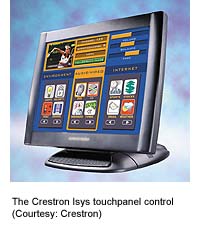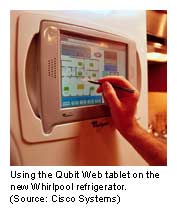|
Cisco wires the home
|
 |
October 6, 2000: 6:07 a.m. ET
Even if you're not James Bond, Cisco Systems can help you live like him
By Staff Writer David Kleinbard
|
NEW YORK (CNNfn) - Imagine sitting at your desk at work and using a Web browser to view live pictures of every room in your house. You see the plumber or the electrician walking down your driveway and unlock the front door using a few keystrokes on your office PC.
With a few more keystrokes, you adjust your home's temperature and turn on the lights in one of the bedrooms. Just then, an e-mail message arrives from your refrigerator. The appliance reminds you that you are out of milk and orange juice and asks you if you want to automatically order more through an online grocer, such as Webvan.
Imagine that later that day, you get home and sit in front of the television. The giant screen is divided into four quadrants. In one quadrant there is a Web browser opened to eBay's home page. In another quadrant is a feature movie, available on demand, that is being streamed to your television at 10 megabits per second. In a third part of the screen is a Web camera view of your child's room so you can keep track of what he's currently destroying. In the fourth panel is the e-mail that has arrived for you today.
Having these capabilities at home may sound like something from a James Bond movie or the Jetsons. The truth, however, is that all these wired features and many more will be available by the end of next year and can be built into a home for less than the cost of a German luxury car.
On display at Cisco's Internet Home
Since late July, the wired house of the near future has been showcased at Cisco Systems' Internet Home, located on the company's sprawling and rapidly expanding corporate campus in San Jose, Calif. The Internet Home features 1,700 feet of living space furnished like a typical upper-middle class residence. What sets this house apart, however, is the state-of-the art electronics and wiring that permeate every room. 
Cisco has generated $19 billion of annual revenue and a market value of $400 billion by selling the switches and routers that form the "plumbing" of the Internet. In the past, the company has focused almost entirely on selling networking equipment to telephone companies, Internet service providers, and other corporate users. Next year, however, Cisco will begin selling a residential gateway device that will be located within consumers' homes.
The residential gateway device is the backbone of Cisco's Internet Home. The device enables voice, video, and data services to be delivered to a home over high-speed, always-on broadband connections. As examples, Internet service can be delivered to every room of the house through a Digital Subscriber Line operating at up to 1.54 megabits per second or a coaxial cable connection operating at up to 2 megabits per second - both of which are more than 25 times faster than a 56K modem.
"We regard the Internet as the next utility," said Rob Sprenger, manager of the Internet Home at Cisco. "Just as you now expect to have water and electricity in a house, in the 21st century the Internet will be just another utility that gets people through the day."
The wiring for being wired
While many of the high-tech features shown in Cisco's Internet Home can be accessed over standard home wiring, reaping the full benefits of modern audio, video and data technology requires a new type of wiring called "category 5," which has five strands within one sheath. One of the nation's largest homebuilders, Kaufman & Broad (KBH: Research, Estimates), is offering this type of wiring as an upgrade option in most regions. In the extremely wired neighborhoods around San Jose and San Francisco, Calif., it's proved to be a very popular.
"Eighty percent of our buyers take the wiring upgrade," said Jennifer Baker, a showroom director for Kaufman & Broad in the San Francisco area. "It's great for resale value."
"Category 5 wiring is very popular with telecommuters and for surround sound in multiple rooms of the house," Baker added. "When you have speakers in several rooms, you don't want to see the wiring, so it's much more aesthetically pleasing." This type of wiring adds about $5,000 to $8,000 to the cost of the home, she said.
Staying in control
Wall-mounted control panels play a prominent role in Cisco's Internet Home and in many luxury homes built within the past two or three years. Seven rooms in Cisco's house of the future are controlled with panels made by Crestron, a privately held company based in Rockleigh, N.J. Crestron started out about 25 years ago making remote control systems for corporate boardrooms and conference rooms. The company branched into controls for luxury homes in response to the booming U.S. economy and the proliferation of audio and video devices found in a typical home.

The Crestron panel in the entranceway to the Cisco house can turn off all the lights in the house, lower the blinds, modify the room temperature, and turn on the home security system with one touch of a button. Almost any combination of actions to the home's heating, lighting, sound, video, or security systems can be programmed into the panel, and the panels can be accessed on a home computer's Web browser.
Each wall-mounted controller costs about $500, and they need to be wired to a master controller that costs about $2,000. A basic system giving each room of a house its own source of control over the home's environment costs about $10,000, including installation labor.
"In the last 12 months there has been an exponential increase in demand for our home systems," said Randy Klein, Crestron's chief operating officer. "People want integration in their homes. The Internet has brought convergence of entertainment and the computer."
Moving on to the kitchen
The kitchen in Cisco's Internet Home features a refrigerator made by Whirlpool (WHR: Research, Estimates) with a special Web tablet made by Qubit Technologies. The refrigerator scans items as they go in and out, keeping an inventory of what it contains. When a home runs out of certain groceries, the Qubit device can automatically order more from an online grocer and schedule a convenient delivery. Since the Qubit tablet can roam up to 200 feet from its base transmitter, users can check their refrigerator contents while sitting in the backyard.

While the Whirlpool refrigerator won't cook an omelet, it does have an integrated Web-browser to search for recipes that match the food items people have on hand. In case you have no idea how to make an omelet, you can prepare the meal by watching a celebrity chef on the Web pad.
You've got mail
In a traditional home, e-mail arrives on the home computer, voice messages are left on an answering machine, and faxes arrive over a separate device. The Cisco Internet Home does away with having to check three or more separate devices for messages by unifying all messaging on the home's personal computer.
When a person leaves a voice message by phone, it shows up as e-mail on the recipient's computer. The recipient simply clicks on an icon and the voice plays over the computer's speakers. Likewise, faxes appear as e-mail attachments.
The technology that enables a user to unify voicemail, e-mail and fax traffic into a single mailbox accessible over an Internet-based network independent of location, time or device is made by Amteva, a company Cisco acquired in April 1999 for about $170 million.
The streaming video on the television in the living room of the Cisco house is made possible by technology from ClearBand, a privately held technology company backed by Brian Flynn and Donald Flynn, a co-founder of Blockbuster Entertainment. Chicago-based ClearBand developed a video encoding solution that enables a broadcaster to transmit data or video streams at varying rates.
"The ClearBand system can sense how big the pipe is leading into a home and avoid congesting it by adjusting the data rate," said Cisco's Sprenger.
The Cisco house is not a fantasy vision of the distant future. Rather, all of the products within it are available now or will be available over the next six to nine months, Sprenger said.
Unlike the Jetsons, Cisco didn't attempt to network the family dog. However, consumers who want to own the dog of the Information Age can buy Tekno the Robotic Puppy online for $40. 
|
|
|
|
|
 |

|

